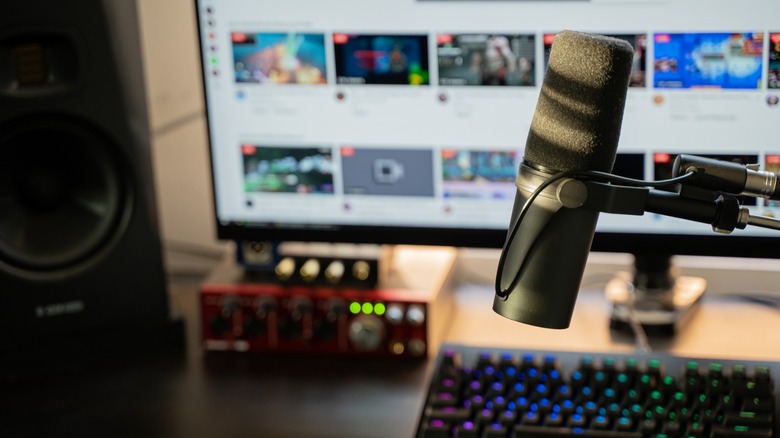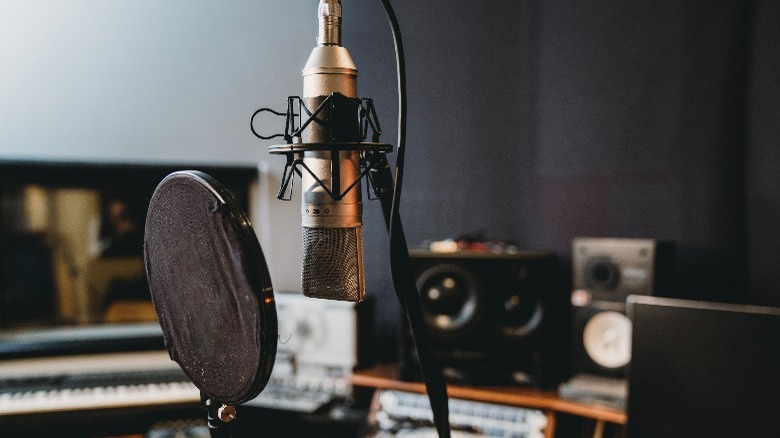
Devon Deth/Shutterstock
We may receive a commission on purchases made from links.
The world of audio production is filled with shiny gear for different purposes. Whether you want to capture audio for podcasts or record music, you’ll be surprised to see how many options are available on the market. Microphones are the most vital piece of equipment in capturing sound. Choosing the right microphone depends on your needs, budget, and intended use. Among the plethora of models available, the Shure SM7B has stood out as one of the most popular microphones among podcasters, musicians, and streamers.
Over the past few years, the Shure SM7B has grown significantly in popularity. From the «Joe Rogan Experience» podcast to A-level artists like Dave Grohl, Jack White, and John Mayer, this microphone has been the focal point of studio gear in many places around the world. Praised for its rich and clear sound, the SM7B is a versatile, dynamic microphone that does an impressive job of capturing both vocals and instruments. However, the SM7B’s excellence in capturing spoken word is what has made it an industry standard.
For a $400 price tag, does the Shure SM7B still live up to the hype in 2024? Or does the competition offer better options on the market? With no further ado, let’s see what makes this dynamic microphone so popular among different users. The information presented in this article is based on the writer’s first-hand experience using various microphones, including the Shure SM7B, in a studio environment.
The Shure SM7B is sturdy and rigid
Introduced in 1973, the SM7 was meant to bring the best of Shure’s popular SM57 and SM58 microphones into a larger package intended for studio use. Initially, it was predominantly used for capturing horns and percussive instruments. However, after it was used for vocals on Michael Jackson’s iconic «Billie Jean» track in 1982, the SM7 gained a lot of popularity for capturing voice.
In 1999, Shure made a new revision, dubbed the SM7A, with an improved humbucking coil and changes in the design of the yoke mount. Later on, Shure introduced the SM7B with an additional larger windscreen in 2001. Though these changes would set the microphones apart, performance acoustically was the same.
Thanks to the chunky black aluminum enclosure and a large windscreen, the Shure SM7B is instantly recognizable. Moreover, the iconic yoke mount design makes it stand out compared to most other microphones on the market. However, aesthetics is not the only thing that makes the SM7B’s design unique. The microphone feels sturdy and rigid in hand and can take a fair amount of abuse before facing any problems. Moreover, the yoke mount allows the mic to connect to a microphone boom arm and angle it conveniently.
In the box, the SM7B comes with two windscreens with different thicknesses. Both do a great job at reducing plosives (the harsh «P» sound, for example), meaning you don’t need an external pop filter. However, the thicker one slightly dampens the high-frequency response.
It is a multi-purpose dynamic microphone
In general, condenser microphones are much more delicate and sensitive than dynamic microphones. This fragility makes them optimal for the studio, where you can capture the smallest details of a vocal or instrument line. However, the downside is that condenser microphones pick up a lot of room sound if you’re not in an acoustically treated environment.
While most producers prefer to work with condenser microphones in a studio environment, the Shure SM7B is one of the few dynamic microphones that can capture audio with desirable attention to detail. Moreover, since the capsule is held in place with a built-in shock mount, you won’t have to deal with booming sounds coming from the mic stand and external vibrations, making it ideal for studio takes.
Still, the sensitivity of the SM7B gets a rating of -59.0 dB, which means it is less sensitive than most condenser microphones. On the other hand, since it has a high maximum SPL of 180 dB, you can record loud sounds without dealing with distortion, making it ideal for horns, loud guitar amps, or screaming vocalists.
The Shure SM7B sounds great for recording podcasts, streaming, radio shows, or any other application for capturing spoken word. Though it is impressively delicate for studio takes, it’s best to remove the windscreen when recording in the studio. For picking up guitar amp sounds, the windscreen makes the high-ends slightly round. Moreover, you’ll have a better presence in the high-mid range If you remove the windscreen and add an external pop filter for recording vocals.
The Shure SM7B has the ideal flat frequency response
Another advantage of the Shure SM7B microphone is its frequency response. It can capture sounds from 50 Hz to 20 kHz in a steady fashion. The diagram for the SM7B stays relatively flat from 50 Hz to 4 kHz. Between 5 kHz and 10 kHz, the microphone introduces some small peaks for a natural brightness.
The SM7B’s flat frequency response allows you to capture sounds as they are and later manipulate them with an equalizer. However, Shure gives you the option to make adjustments to the microphone’s frequency response via EQ switches.
The SM7B comes with two built-in EQ switches. First, a bass roll-off filter attenuates frequencies below the 400 Hz threshold. This allows you to reduce a lot of room hums and rumbling noises. It is also helpful to reduce the proximity effect for bass-heavy vocalists. Moreover, you get a presence boost filter that allows you to boost frequencies between 1 kHz and 10 kHz. The added three dBs of gain makes the sound brighter and helps make speech easier to understand in the recording.
It is also worth mentioning that the SM7B features a cardioid pickup pattern. In simpler terms, it means that the microphone only picks up sound in front of itself in a heart-shaped area. Off-axis sounds or sounds coming from behind the microphone won’t be picked up.
The Shure SM7B has some downsides
No studio equipment is flawless, and the Shure SM7B is no exception. While its clarity and flat frequency make it a suitable microphone for a variety of uses, there are some distinctive problems that buyers should be aware of before they finalize their purchase.
If you have experience using other professional microphones, the first thing that you’ll notice is that the SM7B has a noticeably quieter output than most other vocal mics in its league. Connecting it to any modern-day audio interface with a preamp will give you enough room to work with. However, on some occasions, you might need to get a separate preamp when connecting the microphone to a mixer.
Another disadvantage of the SM7B is its weight. While the aluminum body feels sturdy and protects the mic from fall damage, it adds a lot of heft to the microphone. You’ll need a sturdy monitor arm to keep it steady on a desk.
Last but certainly not least, the microphone is more expensive than most other competitors in the market. You can get the Shure SM7B on Amazon for roughly $400. If you want to get it with a built-in preamp (SM7dB), you’ll have to spend a hundred bucks more. Depending on your needs and intended use, you can find microphones on the market at half that price that deliver similar qualities in 2024.
Rode NT1 and sE Electronics DCM6 are worthy alternatives
As mentioned, the Shure SM7B is more than just a podcast mic. However, if you’re looking for a microphone specifically for music production purposes in a studio environment, opting for a condenser microphone like the Rode NT1 is a better investment. In our review of the NT1 fifth-gen, it stood out as a very crisp and delicate microphone, excellent for tracking vocals and electric guitars in an acoustically-treated room.
Priced at $249 on Amazon, the Rode NT1 is noticeably more affordable than the SM7B. Arguably, it is a better choice for those looking for a versatile microphone for tracking vocals and other instruments, though the differences in frequency response and clarity boil down to personal preference.
On the other hand, if you’re looking for a podcast mic, you can also get the sE Electronics DCM6 DynaCaster microphone. One of the advantages of this mic over the SM7B is that, although it’s a dynamic mic, it comes with a built-in phantom power (8V) switch that boosts the loudness by 30 dBs, meaning that you don’t need a separate preamp to boost up quieter sounds.
Moreover, the DCM6 offers a brighter frequency response in the high-end, making it brighter than the SM7B. You can find the sE Electronics DCM6 DynaCaster microphone on SweetWater for just $149, which is significantly more affordable than the Shure SM7B.
Methodology

Filippobacci/Getty
The content in this post is based on the writer’s personal experience with the Shure SM7B and Rode NT1 microphones in a studio environment. Besides the writer’s years of experience as a musician, songwriter, and music producer, real user reviews and opinions of other sound engineers have been taken into account to ensure this post provides accurate information for a broader audience.